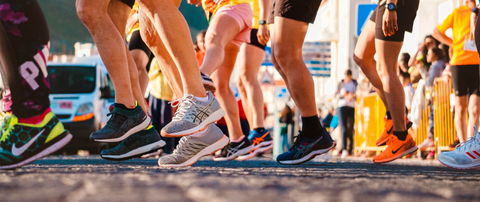TIPS FOR RUNNING WITH FLAT FEET

Running has always been an important element of my fitness and cardio workout routine. I am not what you would consider to be a “serious” runner. I don’t do marathons or even 10k runs. I’m your basic weekend warrior out for a three-mile jog, three to four times a week. My feet are low arched, not quite flat feet but not normal either. And I am now in my 50’s so I’m beginning to feel the effects of all the pounding that my feet and lower extremities have taken over the years. If you’re a runner with flat feet, or nearly flat feet like me, this post has a few tips for you to reduce pain and keep running longer.
If you are an avid runner, give yourself a unique gift...organize a group of runners who are flat-footed like yourself so it's a fair! You can customize your own Medals with unique elements to reward the winners. No doubt this will turn out to be an experience you'll never forget!
When somebody has flat feet, their foot has very little or no arch at all, compared to a person with normal feet and arches. There are several types of flat feet, all of which have one common characteristic, loss of the arch through partial or total collapse. Flexible flat feet are the most common type of flat foot. It usually occurs in both feet and progresses in severity throughout the adult years. Rigid flatfoot, while least common, is the most painful type and is usually associated with inflammation and complications with the tarsal bones of the feet.
INJURIES FROM RUNNING WITH FLAT FEET
It should not be surprising that many running injuries are foot-related as the foot, and the arches of the foot, are the first part of the body to absorb the shock of each step. Even for casual runners like me, this impact can add up over time. The forces absorbed by your feet while running are between three and seven times your body weight. That means the foot of a 150-pound runner absorbs 1,000 pounds or more of force for each foot strike.
In a Runner’s World article, Dr. Lloyd Smith, a sports podiatrist and past president of the American Academy of Podiatric Sports Medicine, said, “A lot of people who run, and run successfully, have flat feet. Yet we do know that people with flat feet have a greater chance of getting injured than people with normal-arched feet.” If you have flat feet, your entire sole comes into full contact with the ground putting strain on your ankles, muscles, ligaments and joints. Overtime, the uneven distribution of body weight can cause other types of overuse injuries. As a result, you may experience a general aching or fatigue in the foot or leg after running. Pain in the heel, arch, ankle or along the outside of the foot are also common. Over time there are various problems that can be caused by running with flat feet, including pain along the shin bone (shin splints), lower back, hip, and knee.
TIPS FOR RUNNING WITH FLAT FEET
- Choose the correct running shoes. This is key for runners with flat feet. Motion control running shoes are good for runners with rigid flat feet, as this type of shoe will control your running motion and prevent any wrong movements. Stability running shoes are better for runners with flexible flat feet since they provide supportive features in the mid-sole area, specifically under the arch of the foot.
- Avoid running on uneven surfaces. When you have flat feet, your feet turn outward when you run, putting additional pressure on your ankles and knee joints. Uneven ground can accentuate your pronation problem and make matters worse.
- Support your ankles and feet when running. A recent LIVESTRONG article entitled “How To Run With Flat Feet” recommends adding orthotic arch support inserts into your running shoes. “Arch support insoles prevent your feet from overpronating when you run, giving extra support to the foot and ankle. The type of orthotic you need depends on the severity of your condition.”
One thing I’ve learned is that gel inserts don’t cut it when it comes to running with flat feet. I tried nearly every kind on the market. It’s why I decided to try a firm arch support. I went with SelectFlex because it’s customizable, allowing me to adjust the level of support I need. The results were really remarkable, but not surprising. A gel insole just isn’t capable of giving you the kind of support an adjustable, firm footbed can. With SelectFlex, my arches feel well supported and my ankles and feet feel better aligned. This has resulted in less overall foot fatigue after my run and a more rapid recovery, so I can get out there and hit the pavement the next day feeling more refreshed. What a great idea.
If you're looking to run farther with less pain, why not give SelectFlex a try?






